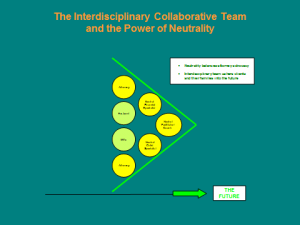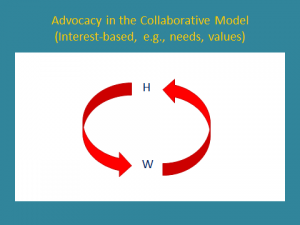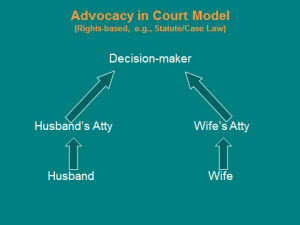
In Part I we learned that advocacy in the “rights-based” Court Model is hard on the people involved because by focusing on the 3
rd-party decision maker, e.g., the judge, the parties care little about each other’s view. As a result, their relationship can become more adversarial. In Part II we learned that by removing the decision maker in the “interest-based” Collaborative Model the parties become the decision makers who resolve mutual problems based on their defined future needs, interests, and goals. But is the removal of the 3
rd party decision maker enough to create a process that is truly “soft” on the people?
Most people who have gone through a divorce agree that divorce is much more than a legal event. More importantly divorce is about changing relationships, improving communication, establishing co-parenting, engaging in problem-solving, and securing a stable financial future. But many divorce processes do not adequately address these more important concerns, thus limiting divorce to simply a legal commodity.
To gain the
added value of improving your relationship with your soon-to-be ex-spouse, of becoming successful co-parents, of mutually planning for the future, and of customizing your financial arrangement to meet the needs of all family members within the resources available, requires the assistance and expertise of NEUTRAL professionals. These neutral professionals include a Neutral Financial Professional, a Neutral Coach, and a Neutral Child Specialist. This team approach is the “secret sauce” used in the Collaborative Model that can transform the experience of this life event into something constructive, affirming, and even peaceful. Obviously, this is of great benefit to children.

In addition to the support and expertise provided, the neutrality of the neutral professionals balances attorney advocacy. This permits the attorney to stay in the problem-solving and interest-based advocacy role for his or her client, while the neutral professionals hold the ground for resolution on behalf of the whole family. This interdisciplinary, holistic approach to advocacy and expertise is what distinguishes the Collaborative Model from any other model out there.
Collaborative professionals like to say this model contributes to world peace one family at a time. If this approach makes sense to you, tell your friends, family, and colleagues about the Collaborative Model and contribute to world peace.
 I heard an advertisement on the radio this morning for a litigating divorce attorney. This attorney discussed the importance of removing the emotion from divorce and treating the divorce itself as a business transaction. I understood her point – emotions can be messy or interfere with rational decision making. However, emotion is often the biggest part of divorce. Or, it often feels that way to clients.
How can we ask clients to strip that piece out of the process? Rather, as a collaborative attorney, I believe that emotion can be used to healthily guide clients to mutually agreeable resolutions that have long-term staying power. I embrace the opportunity to take the client where they are at – emotions and all – and guide them towards resolution. Engaging a mental health professional or coach in the process can sometimes be the greatest asset provided to clients and allow them to balance the emotions with the necessary business-like decisions.
Treating a divorce as a business transaction often leads to client’s making decisions for purely financial reasons. Using emotions and feelings of fairness or equity may lead to clients feeling as if the resolutions more completely address their needs.
For example, if one spouse cheated on the other, an emotional response of anger or vindication may lead to the hurt spouse to ask for more financial pay-out. This sort of punitive outcome is not supported in the law and rarely agreed to out-of-court. However, if the parties have a co-parenting relationship or more emotional needs, a purely business-like interaction may never address some of the underlying emotions. Facilitating a discussion about how both parties are feeling and what they may need in order to move forward may been more beneficial to the clients than any financial resolution. Some clients want an apology or a better understanding of why something happened. Others may need to put in effort to establish a shared narrative or story for others.
The finances matter – sometimes most of all. The collaborative process embraces the financial side of divorce, but also allows for a more holistic and complete approach that can address emotions, if the clients so desire.
I heard an advertisement on the radio this morning for a litigating divorce attorney. This attorney discussed the importance of removing the emotion from divorce and treating the divorce itself as a business transaction. I understood her point – emotions can be messy or interfere with rational decision making. However, emotion is often the biggest part of divorce. Or, it often feels that way to clients.
How can we ask clients to strip that piece out of the process? Rather, as a collaborative attorney, I believe that emotion can be used to healthily guide clients to mutually agreeable resolutions that have long-term staying power. I embrace the opportunity to take the client where they are at – emotions and all – and guide them towards resolution. Engaging a mental health professional or coach in the process can sometimes be the greatest asset provided to clients and allow them to balance the emotions with the necessary business-like decisions.
Treating a divorce as a business transaction often leads to client’s making decisions for purely financial reasons. Using emotions and feelings of fairness or equity may lead to clients feeling as if the resolutions more completely address their needs.
For example, if one spouse cheated on the other, an emotional response of anger or vindication may lead to the hurt spouse to ask for more financial pay-out. This sort of punitive outcome is not supported in the law and rarely agreed to out-of-court. However, if the parties have a co-parenting relationship or more emotional needs, a purely business-like interaction may never address some of the underlying emotions. Facilitating a discussion about how both parties are feeling and what they may need in order to move forward may been more beneficial to the clients than any financial resolution. Some clients want an apology or a better understanding of why something happened. Others may need to put in effort to establish a shared narrative or story for others.
The finances matter – sometimes most of all. The collaborative process embraces the financial side of divorce, but also allows for a more holistic and complete approach that can address emotions, if the clients so desire.  I heard an advertisement on the radio this morning for a litigating divorce attorney. This attorney discussed the importance of removing the emotion from divorce and treating the divorce itself as a business transaction. I understood her point – emotions can be messy or interfere with rational decision making. However, emotion is often the biggest part of divorce. Or, it often feels that way to clients.
How can we ask clients to strip that piece out of the process? Rather, as a collaborative attorney, I believe that emotion can be used to healthily guide clients to mutually agreeable resolutions that have long-term staying power. I embrace the opportunity to take the client where they are at – emotions and all – and guide them towards resolution. Engaging a mental health professional or coach in the process can sometimes be the greatest asset provided to clients and allow them to balance the emotions with the necessary business-like decisions.
Treating a divorce as a business transaction often leads to client’s making decisions for purely financial reasons. Using emotions and feelings of fairness or equity may lead to clients feeling as if the resolutions more completely address their needs.
For example, if one spouse cheated on the other, an emotional response of anger or vindication may lead to the hurt spouse to ask for more financial pay-out. This sort of punitive outcome is not supported in the law and rarely agreed to out-of-court. However, if the parties have a co-parenting relationship or more emotional needs, a purely business-like interaction may never address some of the underlying emotions. Facilitating a discussion about how both parties are feeling and what they may need in order to move forward may been more beneficial to the clients than any financial resolution. Some clients want an apology or a better understanding of why something happened. Others may need to put in effort to establish a shared narrative or story for others.
The finances matter – sometimes most of all. The collaborative process embraces the financial side of divorce, but also allows for a more holistic and complete approach that can address emotions, if the clients so desire.
I heard an advertisement on the radio this morning for a litigating divorce attorney. This attorney discussed the importance of removing the emotion from divorce and treating the divorce itself as a business transaction. I understood her point – emotions can be messy or interfere with rational decision making. However, emotion is often the biggest part of divorce. Or, it often feels that way to clients.
How can we ask clients to strip that piece out of the process? Rather, as a collaborative attorney, I believe that emotion can be used to healthily guide clients to mutually agreeable resolutions that have long-term staying power. I embrace the opportunity to take the client where they are at – emotions and all – and guide them towards resolution. Engaging a mental health professional or coach in the process can sometimes be the greatest asset provided to clients and allow them to balance the emotions with the necessary business-like decisions.
Treating a divorce as a business transaction often leads to client’s making decisions for purely financial reasons. Using emotions and feelings of fairness or equity may lead to clients feeling as if the resolutions more completely address their needs.
For example, if one spouse cheated on the other, an emotional response of anger or vindication may lead to the hurt spouse to ask for more financial pay-out. This sort of punitive outcome is not supported in the law and rarely agreed to out-of-court. However, if the parties have a co-parenting relationship or more emotional needs, a purely business-like interaction may never address some of the underlying emotions. Facilitating a discussion about how both parties are feeling and what they may need in order to move forward may been more beneficial to the clients than any financial resolution. Some clients want an apology or a better understanding of why something happened. Others may need to put in effort to establish a shared narrative or story for others.
The finances matter – sometimes most of all. The collaborative process embraces the financial side of divorce, but also allows for a more holistic and complete approach that can address emotions, if the clients so desire. 





 In
In 





